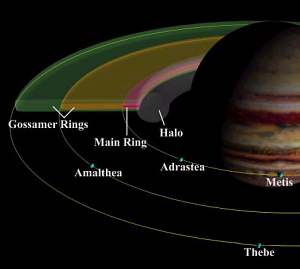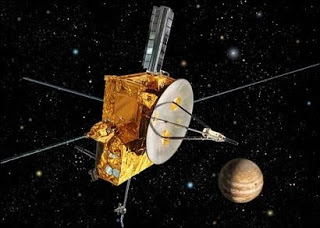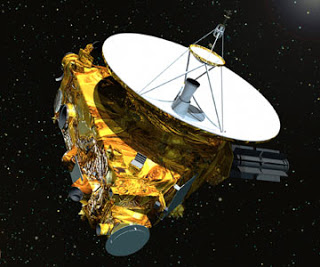Astronomy

Mass : 1.8986×1027 kg
Volume : 1.4313×1015 km3
Gravity : 24.79 m/s²
Distance from Sun : 778,500,000 km
Orbital period : 12 years
Length of day : 0d 9h 56m
Satellites : 67
The colorful bands of Jupiter are arranged in dark belts and light zones created by strong east-west winds in the planet's upper atmosphere traveling more than 400 miles per hour (640 kilometers per hour). The white clouds in the zones are made of crystals of frozen ammonia, while darker clouds of other chemicals are found in the belts. At the deepest visible levels are blue clouds.
The most extraordinary feature on Jupiter is undoubtedly the Great Red Spot, a giant hurricane-like storm seen for more than 300 years. At its widest, the Great Red Spot is three times the diameter of the Earth, and its edge spins counterclockwise around its center at a speed of about 225 miles (360 kilometers) per hour. The color of the storm, which usually varies from brick red to slightly brown, may come from small amounts of sulfur and phosphorus in the ammonia crystals in Jupiter's clouds. Every now and again, the Great Red Spot seems to fade entirely.




- Sky Watching Dec 18 - 25
Sky Watching 2012,December,18-25 Tue., December 18, 4 a.m. Ceres at opposition...
- Do You Know - 3
Do You Know? - 3 1 . What is the name of the 2nd biggest planet in our solar system? Ans: Saturn ...
- Picture Of The Day Oct - 25
Picture Of The Day October 25 , Thursday The Cone Nebula (NGC 2264) ...
- Picture Of The Day
Picture Of The Day October 17, Wednesday ...
- Astronomy Quiz
Do You Know? 1. What is the brightest star in the night sky at any time? ...
Astronomy
Planet Jupiter
Jupiter

Mass : 1.8986×1027 kg
Volume : 1.4313×1015 km3
Gravity : 24.79 m/s²
Distance from Sun : 778,500,000 km
Orbital period : 12 years
Length of day : 0d 9h 56m
Satellites : 67
Jupiter was the king of the gods in Roman mythology ? a fitting name for the largest of the planets. In a similar manner, the ancient Greeks named the planet after Zeus, the king of the Greek pantheon.
Jupiter helped revolutionize the way we saw the universe and ourselves in 1610, when Galileo discovered Jupiter's four large moons ? Io, Europa, Ganymede and Callisto, now known as the Galilean moons. This was the first time celestial bodies were not seen circling the Earth, major support of the Copernican view that Earth was not the center of the universe.
Jupiter is the most massive planet in our solar system, more than twice as massive as all the other planets combined, and had it been about 80 times more massive, it would have actually become a star instead of a planet. Its atmosphere resembles that of the sun, made up mostly of hydrogen and helium, and with four large moons and many smaller moons in orbit around it, Jupiter by itself forms a kind of miniature solar system. All told, the immense volume of Jupiter could hold more than 1,300 Earths.The colorful bands of Jupiter are arranged in dark belts and light zones created by strong east-west winds in the planet's upper atmosphere traveling more than 400 miles per hour (640 kilometers per hour). The white clouds in the zones are made of crystals of frozen ammonia, while darker clouds of other chemicals are found in the belts. At the deepest visible levels are blue clouds.
The most extraordinary feature on Jupiter is undoubtedly the Great Red Spot, a giant hurricane-like storm seen for more than 300 years. At its widest, the Great Red Spot is three times the diameter of the Earth, and its edge spins counterclockwise around its center at a speed of about 225 miles (360 kilometers) per hour. The color of the storm, which usually varies from brick red to slightly brown, may come from small amounts of sulfur and phosphorus in the ammonia crystals in Jupiter's clouds. Every now and again, the Great Red Spot seems to fade entirely.
- Magnetic Field :
Jupiter?s magnetic field is 14 times as strong as Earth
- Rings :
Jupiter has three thin rings around its equator. They are much fainter than the rings of Saturn.


- Gravity :
Because of the giant size of Jupiter, the gravity there is 2.4 times more than on Earth. If you weigh 200lbs on Earth, you would feel like you weighed 480lbs on Jupiter
- Comet Shoemaker-Levy 9 :
In March 1993, astronomers Eugene Shoemaker, Carolyn Shoemaker, and David H. Levy discovered a comet near Jupiter. Astronomers witnessed a spectacular event when 21 fragments of a comet named Shoemaker-Levy 9 crashed into Jupiter's atmosphere. The impacts caused tremendous explosions, some scattering debris over areas larger than the diameter of Earth.
- Jupiter related Spacecraft:
The United States has sent six space probes to Jupiter: (1) Pioneer 10 (December 1973) (2) Pioneer 11 (December 1974) (3) Voyager 1 (1979) (4) Voyager 2 (1979) (5) Ulysses (February 1992) and (6) Galileo.
In December 1995, NASA's Galileo spacecraft dropped a probe into Jupiter's atmosphere, which collected the first direct measurements of the atmosphere.
Cassini made a flyby in 2000 on its way to Saturn. NASA?s New Horizons spacecraft made its flyby in 2007.

(ulysses)

( New Horizons )
- Sky Watching Dec 18 - 25
Sky Watching 2012,December,18-25 Tue., December 18, 4 a.m. Ceres at opposition...
- Do You Know - 3
Do You Know? - 3 1 . What is the name of the 2nd biggest planet in our solar system? Ans: Saturn ...
- Picture Of The Day Oct - 25
Picture Of The Day October 25 , Thursday The Cone Nebula (NGC 2264) ...
- Picture Of The Day
Picture Of The Day October 17, Wednesday ...
- Astronomy Quiz
Do You Know? 1. What is the brightest star in the night sky at any time? ...
